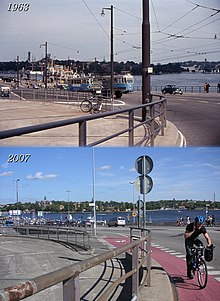Transport in Sweden
| Public transportation in |
|---|
Transport in Sweden is available for all four main modes of transport—air, bus, ferry and rail[1]—assisting residents and visitors without their own vehicle to travel around much of Sweden's 450,295 square kilometres (173,860 sq mi).
Rail
Rail transport is operated by SJ, DSBFirst, Green Cargo, Vy Tåg and more.[2] Most counties have companies that provide ticketing, marketing and financing of local passenger rail, but the actual operation is undertaken by the aforementioned companies. There is 11,663 km of railway, of which 9,227 km is nationalised and 3,594 km is county-owned. As of 2008, over 11,000 km of rails are 1,435 mm (4 ft 8+1⁄2 in) guage, of which 7,531 km is electrified. There are 65 km of 891 mm (2 ft 11+3⁄32 in) guage.
Trains generally keep to the left, as opposed to all neighbouring countries.
Light rail and metros
Stockholm Metro (Stockholms tunnelbana) is the only metro system in Sweden.
Cities with light rail (trams);
- Gothenburg tram– consisting of 190 km on a total track length of 161 km
- Norrköping tramway– small but growing
- Stockholm: Tvärbanan, Nockebybanan, Lidingöbanan, Spårväg City
- Lund – Lund tramway
Stockholm previously had a large tram network, but this was discontinued in favour of bus and metro; a revival of the tram network was seen in the construction of Tvärbanan in the late 1990s and early 2000s.
Railway links with adjacent countries
- Eda (Stockholm-Oslo), Storlien (Östersund-Trondheim, not electrified Storlien-Trondheim) and Riksgränsen (Narvik-Kiruna)
- same gauge – same voltage – same protection system. Most Swedish and Norwegian rail vehicles can cross the border. As there is only single-track at all border crossings, there is no need for bridges to make the transition from left- to right-hand traffic.
- same gauge – same voltage – same
-
- break-of-gauge1,435 mm (4 ft 8+1⁄2 in)/1,524 mm (5 ft) – other protection system. All freight has to be reloaded. No passenger traffic by rail.
- Öresund bridge
- same gauge – voltage change 25kVAC– other protection system. Only custom made locomotives or EMUs can cross the border. Bridges to make the transition from left- to right-hand traffic, are located north of Malmö, so all traffic south of Malmö is in right-hand traffic.
- same gauge – voltage change
Road

Sweden has right-hand traffic today, like all its neighbours.
Sweden had left-hand traffic (Vänstertrafik in
Nevertheless, in 1963 the Riksdag passed legislation ordering the switch to right-hand traffic. The changeover took place on a Sunday morning at 5am on September 3, 1967, which was known in Swedish as Dagen H (H-Day), the 'H' standing for Högertrafik or right-hand traffic.
Since Swedish cars were left-hand drive, experts had suggested that changing to driving on the right would reduce accidents, because drivers would have a better view of the road ahead. Indeed, fatal car-to-car and car-to-pedestrian accidents did drop sharply as a result. This was likely due to drivers initially being more careful and because of the initially very low speed limits, since accident rates soon returned to nearly the same as earlier.
Total roadways: 572,900 km, as of 2009.
Motorways
Ports and harbours
There are 2,052 kilometres (1,275 mi) of waterways in Sweden.
There are 19 ports which are navigable to small steamers and barges.
- Gothenburg
- Gävle
- Halmstad
- Helsingborg
- Hudiksvall
- Kalmar
- Kapellskär
- Karlshamn
- Karlskrona
- Lidköping
- Malmö
- Norrköping
- Nynäshamn
- Stockholm
- Sundsvall
- Sölvesborg
- Trelleborg
- Varberg
- Västerås
Air
) being over 3,047 metres (9,997 ft) long. There are over eighty airports with unpaved runways. A large number of war-time airfields exist in various lengths, usually built into roads, and are usually less than 1,000 metres (3,300 ft) long.Every hospital, airport and military base has a helipad.
List of large airports
- Säve Airport, Gothenburg
- Göteborg Landvetter Airport
- Jönköping Airport
- Luleå Airport
- Malmö Airport
- Stockholm Arlanda Airport
- Stockholm Bromma Airport
- Stockholm Skavsta Airport
- Umeå Airport
- Växjö-Kronoberg Airport
See also
- Government agencies in Sweden
- Scandinavian Airlines
- Saab, Scania
- Estonia disaster
- Transport in Denmark
- Transport in Finland
- Transport in Iceland
- Transport in Norway
References
- ^ "Everything you need to know about getting around in Sweden". Lonely Planet. Retrieved 2024-01-11.
- ^ "Public transportation". visitsweden.com. Retrieved 2024-01-11.
External links
![]() Media related to Transport in Sweden at Wikimedia Commons
Media related to Transport in Sweden at Wikimedia Commons
